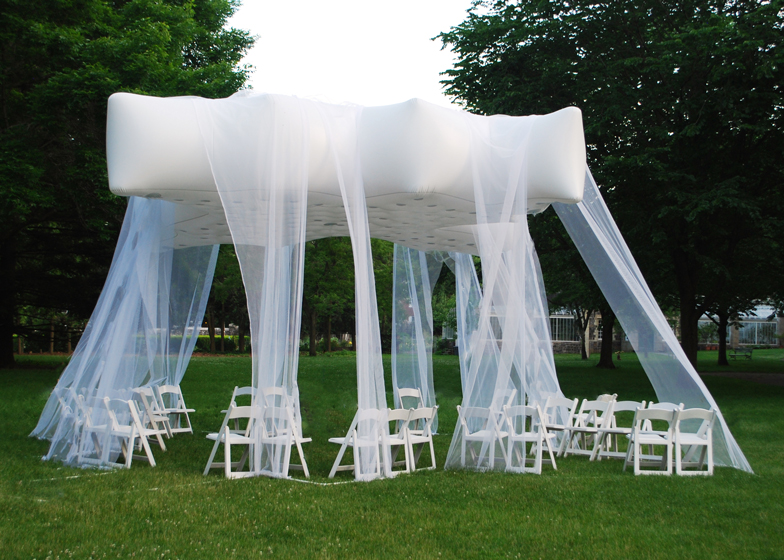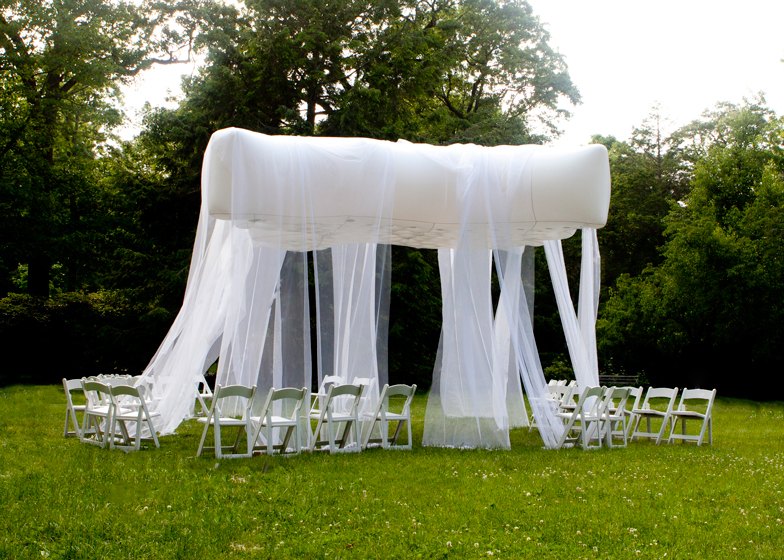American studio Qastic has created an inflatable pavilion with a floating roof held down by fabric veils (+ slideshow).
Called Floatastic, the structure was designed by Connecticut firm Qastic for a wedding ceremony. They intended to create a temporary shelter without imposing any loads on the ground.
A giant horizontal white balloon is filled with helium. As it rises upwards, a series of fixed fabric veils keep the inflatable overhead and appear to dangle like jellyfish tentacles. "Buoyancy is achieved through the efficient harnessing of a noble gas," said Qastic.
The designers said that the floating pavillion is the result of research into buoyancy and structures that are made by reversing the position of the load.
"Since the surrounding environment and microclimate fluctuate in every 24-hour cycle, our studies found that the floating pavilion will experience many buoyant conditions which are unique but steady," said the firm.
Here's a film featuring the structure floating in the wind:
We've featured other stories about inflatable structures recently, including a pop-up pavilion that looks like a soap bubble and a twisted tubular inflatable pavilion installed in east London.
See more inflatable architecture and design »
See more pavilion design »
Photographs are by Net Martin Studio.
Here's more from Qastic Lab:
Floatastic
Balance Through Buoyancy is a research base pavilion called "Floatastic" by QASTIC Lab, which was designed and built for a private client to serve as a temporary shade pavilion for a wedding ceremony in Edgerton Park, in New Haven Connecticut - an Olmsted planned landscape.
This deployable structure aims to create a floated shelter which avoids imposing any loads to the ground, which traditional structures require. Instead it proposes a well-fabricated balloon, which is filled with Helium to raise the imposed loads of fabric veils and any possible dynamic environmental loads toward the sky.
Buoyancy is achieved through the efficient harnessing of a noble gas. The idea of 'flesh' is explored through the pavilions possible functions and effects, by which an abstracted mass can impose on fabric surfaces in both relaxation and tension.
It is within this dialogue of the helium container and the loads that we can test possible architectural and spatial effects, with articulation between Balloon edges and fabric veils exploring the possibilities in which the complex surface veils are relaxed or in tension in double curvature configurations.
Making use of the method of reversing load bearing systems, the form of the pavilion is defined by geometrically precise formwork that is then fabricated with randomly varying edges both for the horizontal balloon and the PVC pipes on the ground to allow for varied functions at different heights, climates and locations.
Since the surrounding environment and microclimate fluctuate in every 24 hours cycle, our studies found that the floating pavilion will experience many buoyant conditions which are unique however steady.
Metaphorically, Floatastic envisioned to be a surrealistic and breathtaking imitation of the Jellyfish that appear alive and tries to swim against the external forces in the water. However, rather than being in the water, Floatastic questions its audiences to unconsciously know if they are floating in the sea or on the ground.
Architects: QASTIC Lab
Location: Edgerton Park, New Haven, Connecticut. USA
Constructor: QASTIC Lab
Client: Jahangir Mohamadzadeh
Designer & Team Leader: Mahdi Alibakhshian
Design and fabrication Team: Ali Sadeghian, Reza Zia, Ahmad Jamei, Carlos Bugatti, Delara Zarrinabadi, Lili Saliani
Design & Fabrication Consultant: Nathaniel Hadley, Mohamad Reza Mojahedi
Conceptual & Visualization Consultant: Gregory Hurcomb
Exhibition Period: July 2013






